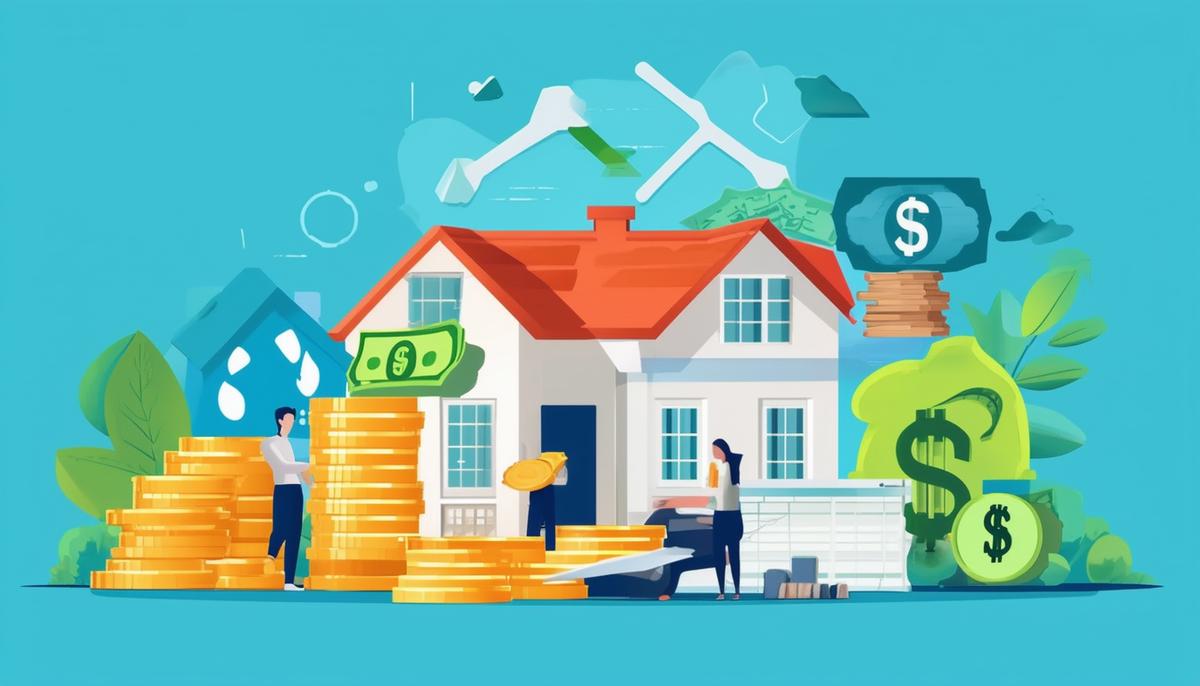Understanding the Components of Mortgage Payments
Let's break down the key components of a mortgage payment. The principal is the amount you borrowed to buy your home, while interest is what you pay for the privilege of borrowing that money.
But a typical mortgage payment isn't just principal and interest. There's also escrow, homeowners insurance, and property taxes. Escrow acts like a piggy bank that your lender uses to cover property taxes and insurance. Part of your monthly payment goes into this account, ensuring these expenses are paid on time.
Homeowners insurance protects against various misfortunes, like roof damage or unexpected events. Your lender usually includes this in your payment for your convenience.
Property taxes are based on your home's value and your area's tax rate. It's an ongoing cost you'll pay as long as you own property. Often, these taxes are included in your lender's escrow account.
Here's a breakdown of how these costs might look monthly:
| Component | Description | Estimated Monthly Cost |
|---|---|---|
| Principal | Payback of borrowed money | $750 |
| Interest | Cost of borrowing | $450 |
| Escrow | Taxes and insurance | $150 |
| Homeowners Insurance | Property coverage | $50 |
| Property Taxes | Local government's cut | $100 |
| Total Monthly Payment | Principal + Interest + Escrow + Insurance + Taxes | $1,500 |
Understanding these components can prevent financial surprises down the road. It's wise to check your payment details regularly to keep your finances in check.

Upfront and Long-term Costs of Homeownership
Let's explore the upfront costs of buying a home. The down payment is your first commitment, usually ranging from 3.5% for an FHA loan to 20% for a conventional one. A larger down payment means lower monthly payments and potentially avoiding Private Mortgage Insurance (PMI).
Closing costs typically range from 2% to 5% of the purchase price. This includes fees for appraisal, home inspection, title insurance, and other administrative expenses.
Long-term costs of homeownership:
- Property taxes: Based on your home's assessed value and local tax rates. They're an ongoing expense that can fluctuate over time.
- Homeowners insurance: Protects you from financial loss due to unexpected events. It's often part of your monthly escrow payments if you have a mortgage.
- HOA fees: If you live in a community with a Homeowners Association, be prepared for these fees. They can cover various services and amenities.
- Maintenance and repairs: An inevitable part of homeownership. Budget around 1% of your home's purchase price annually for these surprises.
To manage these costs effectively, create a comprehensive budget. Start with a conservative estimate of your income and expenses, adding a cushion for unpredictable costs. Build an emergency fund covering three to six months of living expenses.
"Consider adopting a sinking fund strategy for big-ticket items, setting aside money each month for predictable but infrequent costs."
For those unexpected repairs, a home warranty can provide additional peace of mind.
Buying a house is a significant commitment, but with proper preparation, you can handle both the initial expenses and ongoing costs while maintaining your excitement about homeownership.

Hidden Fees and Unexpected Expenses
As a new homeowner, it's important to be aware of some hidden fees and unexpected expenses that come with the territory.
- Higher utility bills: Common when moving from an apartment to a larger home. More space means more energy consumption for heating and cooling. Consider investing in energy-efficient appliances and smart thermostats to help manage these costs.
- Security system setup: Can be more complex and pricier than anticipated. Whether you choose a professional service or a DIY option, factor in the costs of equipment and installation.
- New furnishings: Can quickly add up, especially if you're moving into a larger space. Be mindful of your budget when outfitting your new home.
- Landscaping and tree care: Surprisingly expensive. Regular lawn care, tree trimming, and other outdoor maintenance should be factored into your budget.
- Appliance replacement: Old appliances that come with the house might need to be replaced sooner than expected.
An emergency fund is crucial for homeowners. Aim for a fund that covers three to six months of living expenses to handle unexpected repairs or major system failures.
Before closing on a home, invest in thorough inspections. A comprehensive inspection can reveal potential issues and help you avoid costly surprises down the road.
While homeownership comes with its share of unexpected expenses, being prepared and informed can help you manage these costs effectively. Remember, owning a home is an adventure – with proper planning, you can enjoy the journey while building your dream home.

Strategies to Avoid Hidden Costs
Let's explore some savvy strategies to sidestep hidden costs while managing mortgage payments and homeownership like a pro.
- Scout for hidden fees by examining every document thoroughly. Read your loan agreement carefully and ask your lender to explain any charges you don't understand. What's this "service fee"? Why is there a "processing charge"? Uncover these stealth fees before they add up.
- Shop around for the best mortgage offer. Different lenders have different fees and interest rates—compare multiple offers to find the one that keeps your monthly payments manageable. Don't hesitate to ask lenders to match a competitor's offer.
- Negotiate fees like mortgage origination, appraisal costs, and escrow charges. A little persistence can go a long way in reducing these expenses.
- Regular maintenance is key to avoiding massive, surprise payouts later. Schedule routine checks for your HVAC system, plumbing, and roof. Don't wait until winter to find out your heater needs repairs.
Build an emergency fund with three to six months' worth of expenses. This can soften the blow when unexpected home repairs are needed.
Consider the pros and cons of fixed-rate versus adjustable-rate mortgages. Fixed-rate mortgages offer stability, while adjustable-rate mortgages (ARMs) may have lower initial rates but can change over time. Choose based on your long-term plans and risk tolerance.
Stay on top of recurring expenses through careful budgeting and planning. Create a realistic monthly budget that includes:
- Mortgage payments
- Utilities
- Insurance
- Property taxes
- HOA fees
Factor in seasonal costs like landscaping and snow removal.
Set up a sinking fund for larger, less frequent expenses like property taxes or home improvements. Setting aside a little each month can make these costs more manageable when they come due.
Consider a home warranty to help mitigate costs associated with major systems and appliances failing. While it won't cover everything, it can provide some financial protection1.
By embracing these strategies, you can make informed choices and keep the excitement of homeownership alive while managing your finances effectively.

Owning a home is more than just a financial commitment; it's about creating a space where life happens. By staying informed about all potential costs—from hidden fees to unexpected repairs—you can manage your budget effectively and enjoy the journey of homeownership. Remember, preparation is key to turning your house into a true sanctuary.

